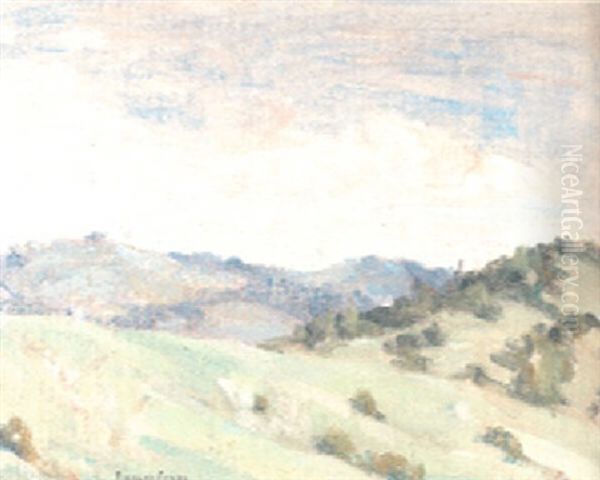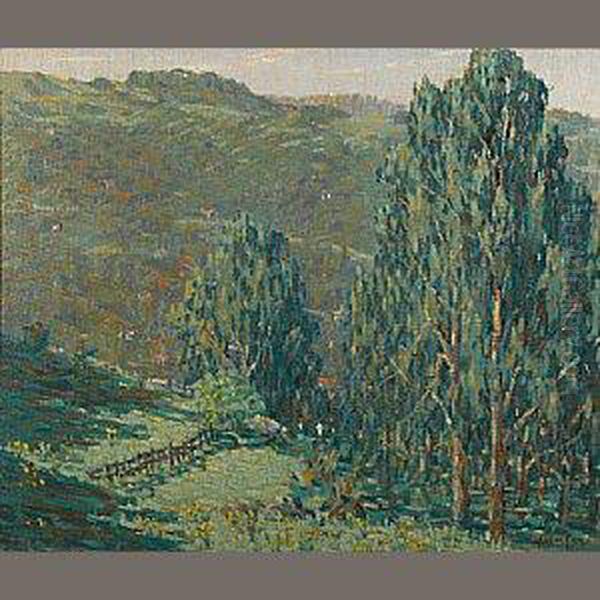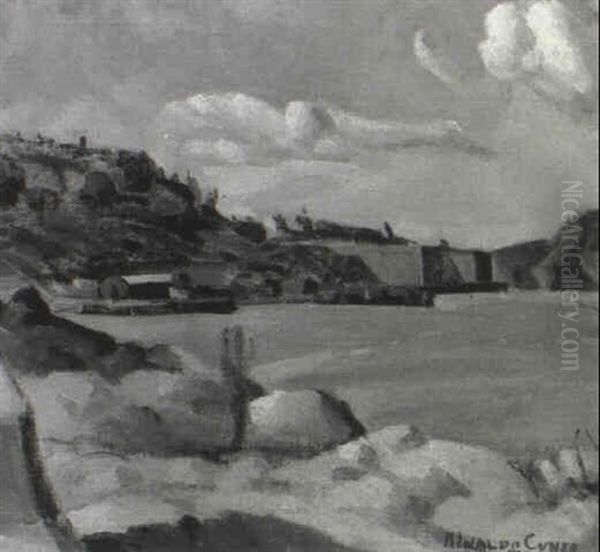
Rinaldo Cuneo, a name synonymous with the vibrant early twentieth-century Californian art scene, stands as a pivotal figure whose canvases captured the unique light and topography of his native state. Dubbed "The Painter of San Francisco," his work offers a profound visual dialogue with the landscapes that shaped him, from the rolling hills of Marin County to the burgeoning cityscapes of the Bay Area. An artist of Italian-American heritage, Cuneo's journey through Impressionism and beyond reflects both his European training and his deep connection to the American West, leaving an indelible mark on the history of Californian art.
Early Life and Artistic Awakening in San Francisco
Born in San Francisco on July 2, 1877, Rinaldo Cuneo was part of a wave of Italian immigrant families that contributed significantly to the cultural fabric of California. His parents, Giovanni (John) Cuneo and Annie Garibaldi Cuneo, hailed from the Liguria region of Italy, specifically Coreglia Ligure. They were among the early Italian settlers in San Francisco, arriving in the latter half of the 19th century. The Cuneo family was artistically inclined; Rinaldo's father, Giovanni, was a musician and also ran a steamship ticket agency, a common enterprise for Italian immigrants facilitating passage for others. More notably, Rinaldo's elder brothers, Cyrus Cuneo (1879-1916) and Egisto Cuneo (1890-1972), also pursued careers as artists, creating an environment rich with creative stimulus.
Rinaldo's initial foray into the art world was not immediate. He served in the U.S. Navy during the Spanish-American War (1898-1899) for three years, an experience that perhaps broadened his horizons but delayed his formal artistic training. Upon his return, he began his studies at the Mark Hopkins Institute of Art in San Francisco. This institution, later to become the San Francisco Art Institute, was a crucible for many aspiring Californian artists. Here, Cuneo studied under influential figures such as Arthur Frank Mathews and Gottardo Piazzoni. Mathews, a leading proponent of the California Decorative Style, emphasized tonalism and a harmonious, almost mural-like quality in painting, which likely left an impression on the young Cuneo. Piazzoni, another significant Californian Tonalist and muralist, would also have provided a strong regional artistic grounding.

The San Francisco of Cuneo's youth was a city of dynamic change and artistic ferment, still recovering and rebuilding its identity after the devastating 1906 earthquake and fire. This environment, coupled with his family's artistic leanings, undoubtedly nurtured his burgeoning talent and ambition. His early works from this period began to show a sensitivity to the local landscape, a theme that would dominate his career.
Parisian Sojourn and the Embrace of Modernism
Seeking to further refine his skills and immerse himself in the avant-garde currents of European art, Rinaldo Cuneo, like many American artists of his generation, traveled to Paris. From 1911 to 1913, he enrolled at the prestigious Académie Colarossi. This academy was a popular alternative to the more conservative École des Beaux-Arts, attracting students from around the world, including notable figures like Amedeo Modigliani, Camille Claudel, and a host of American expatriates. The Colarossi offered a liberal environment where students could work from live models and experiment with emerging styles.
During his time in Paris, Cuneo was exposed to the full force of Impressionism, Post-Impressionism, and the nascent Fauvist and Cubist movements. While he did not fully adopt the more radical tenets of Cubism, the Impressionists' focus on light, color, and capturing fleeting moments profoundly influenced his approach. He learned to depict dynamic landforms, the architectural rhythms of cityscapes, including bridges and rooftops, and the pastoral charm of rural farms. His palette likely brightened, and his brushwork became more expressive under these influences. He also spent time painting in Whistler's London studio, further broadening his European experience. It is documented that Cuneo exhibited at the Salon des Indépendants in Paris, a significant juried exhibition that showcased more progressive art, indicating his engagement with the contemporary art scene. This period was crucial in shaping his artistic vision, providing him with a sophisticated technical and conceptual framework that he would later adapt to the Californian context.
Return to California: A Flourishing Career
Upon returning to the San Francisco Bay Area around 1913, Rinaldo Cuneo brought with him a refined artistic sensibility. He quickly established himself as a significant presence in the local art community. His work began to be featured in important exhibitions, including the landmark Panama-Pacific International Exposition (PPIE) held in San Francisco in 1915. This grand event, celebrating the opening of the Panama Canal and showcasing San Francisco's recovery from the 1906 earthquake, was a major cultural happening and provided a platform for artists like Cuneo to gain wider recognition. He received a silver medal for his submissions, a testament to his growing stature.

Throughout the 1910s, 1920s, and 1930s, Cuneo's reputation solidified. He became known for his evocative landscapes of Northern California, particularly the rugged hills and dramatic coastlines of Marin County, the agricultural richness of the Napa Valley, and the urban scenes of San Francisco. His style, while rooted in Impressionism, developed a distinctly Californian character. He masterfully captured the atmospheric conditions of the region – the clear, bright light, the coastal fog, and the unique color palette of the Californian terrain. His paintings often featured bold compositions, a rich impasto, and a vibrant, though sometimes subtly modulated, use of color.
Cuneo exhibited extensively from 1916 until his death. His works were shown at prominent venues such as the Palace of the Legion of Honor (where he had a solo exhibition in 1928), the San Francisco Museum of Art (later SFMOMA), and the de Young Museum in San Francisco. He also had solo exhibitions in Los Angeles, and his work was included in shows in Rome, London, and Paris, reflecting his international connections. In 1935, at the inaugural exhibition of the San Francisco Museum of Art, Cuneo was honored by having more of his works displayed than any other early Californian artist. His painting, "California Hills," received the museum's purchase prize that year, cementing its place in a significant public collection and underscoring his importance. He was an active member of the San Francisco Art Association and the Bohemian Club, further integrating him into the city's artistic and cultural life.
The Coit Tower Murals: A Public Art Landmark
One of Rinaldo Cuneo's most enduring public contributions came during the Great Depression with his involvement in the Coit Tower mural project. In 1933-34, under the auspices of the Public Works of Art Project (PWAP), a New Deal program designed to employ artists, twenty-six artists, including Cuneo, were commissioned to create frescoes and murals within Coit Tower on Telegraph Hill. This project was one of the first major federally funded public art initiatives in the United States and aimed to depict various aspects of life in California.
Cuneo was assigned a significant space within the tower. He created two large semi-dome lunette murals titled "Bay Area Hills." These oil-on-canvas works, each measuring approximately 108 x 54 inches, depict the characteristic rolling landscapes of the region, rendered in his signature style with a focus on form, light, and a somewhat stylized, modern sensibility. His murals are less overtly political than some of the others in Coit Tower, which famously sparked controversy for their perceived leftist themes, particularly those by artists like Victor Arnautoff, a student of Diego Rivera, or Bernard Zakheim. Cuneo's contribution, however, focused on the enduring beauty and character of the Californian landscape, a theme consistent with his broader oeuvre.

He worked alongside a diverse group of artists on the Coit Tower project, including Maxine Albro, Ray Bertrand, Jane Berlandina, Ralph Stackpole (who supervised the sculpture), and Moya del Pino. The project fostered a sense of community among artists and left San Francisco with an iconic landmark filled with art that reflected the era's social and artistic concerns. Cuneo's "Bay Area Hills" remains a highlight, showcasing his mastery of landscape on a grand, public scale.
Artistic Style, Themes, and Influences
Rinaldo Cuneo's artistic style is often categorized within California Impressionism or Post-Impressionism, though his work evolved and possessed unique characteristics. His early training under Tonalists like Arthur Mathews and Gottardo Piazzoni instilled in him a strong sense of composition and an appreciation for atmospheric effects. His Parisian experience then infused his work with the brighter palette and broken brushwork of Impressionism, influenced by masters like Claude Monet and Camille Pissarro.
However, Cuneo was not merely an imitator. He adapted these European influences to the specific light and forms of California. His landscapes are characterized by a strong sense of place. He had a particular affinity for the hills of Marin County and the East Bay, often depicting their undulating forms with a rhythmic, almost sculptural quality. Works like "Marin Hills," "California Hills" (the SFMOMA prize winner), and his Coit Tower murals exemplify this focus. He was adept at capturing the interplay of light and shadow on these hills, often using a palette that ranged from earthy ochres, greens, and browns to vibrant blues and purples, especially in his skies.
Cuneo also painted urban scenes of San Francisco, capturing its unique topography and architecture. His cityscapes, while less numerous than his pure landscapes, demonstrate his versatility. He was interested in the structure and form of the built environment, from sweeping bay views to more intimate depictions of streets and buildings. His style could vary from a more traditional Impressionistic approach to a bolder, more simplified, and modern treatment of form, sometimes hinting at influences from artists like Cézanne in his emphasis on underlying geometric structures.
Throughout his career, Cuneo's work was praised for its sincerity, its robust handling of paint, and its lyrical interpretation of the Californian scene. He was part of a generation of Californian artists, including Guy Rose, William Wendt, Granville Redmond, and E. Charlton Fortune, who sought to define a regional artistic identity. While sharing some common ground with the Southern California Impressionists, Cuneo's work, along with that of other Northern California painters like Piazzoni or Maynard Dixon (though Dixon's style was quite different), often possessed a distinct Northern Californian sensibility – perhaps a bit more rugged, atmospheric, and occasionally more introspective.
The Cuneo Artistic Dynasty
The artistic talent within the Cuneo family was remarkable. Rinaldo was one of three brothers who became professional artists. His elder brother, Cyrus Cuneo (1879-1916), moved to England and became a successful illustrator and painter, known for his dramatic and action-filled scenes. Cyrus's work appeared in major British publications, and he exhibited at the Royal Academy. Tragically, Cyrus died relatively young from blood poisoning.
Rinaldo's younger brother, Egisto Cuneo (1890-1972), also pursued an artistic career, though perhaps with less widespread fame than Rinaldo or Cyrus. He, too, was a painter, and his work was exhibited alongside Rinaldo's in family-focused shows, such as the 1990 exhibition "Cuneo: A Family of Early California Artists" at the Museo ItaloAmericano in San Francisco. This exhibition highlighted the collective contribution of this Italian-American family to the Californian art scene.
The artistic lineage continued into the next generation with Cyrus's son, Terence Tenison Cuneo (1907-1996). Born in London, Terence Cuneo became one of Britain's most celebrated and versatile painters of the 20th century. He was particularly renowned for his paintings of railways, industrial scenes, ceremonial occasions (including the coronation of Queen Elizabeth II), and portraits. He was also famous for including a small, often hidden, mouse in his paintings, which became his trademark. While Rinaldo's direct influence on his nephew Terence might have been limited by geography, the family's strong artistic tradition undoubtedly played a role.
Later Years, Challenges, and Legacy
Despite his artistic successes and critical acclaim, Rinaldo Cuneo, like many artists, faced financial difficulties, particularly during the Great Depression. The art market contracted significantly, and even established artists struggled to make a living solely from their work. It is documented that Cuneo, at times, had to rely on the family's steamship ticket agency business, which his father had established, to supplement his income. This reality underscores the precarious nature of an artistic career, even for a painter of his caliber.
The economic hardships of the Depression era took a toll on many. Rinaldo Cuneo passed away in San Francisco on December 27, 1939, at the age of 62. His death marked the end of a significant chapter in Californian art.
Rinaldo Cuneo's legacy, however, endures. He is remembered as "The Painter of San Francisco" and a key figure in the development of California Impressionism and landscape painting. His works are held in numerous public and private collections, including the San Francisco Museum of Modern Art, the de Young Museum, the Oakland Museum of California, and the Los Angeles County Museum of Art. His paintings continue to be admired for their vibrant depiction of the Californian landscape, their technical skill, and their heartfelt connection to his native region.
His contribution to the Coit Tower murals ensures his visibility to a broad public, and his broader body of work provides a rich visual record of California in the early 20th century. He successfully synthesized European modernist influences with a deeply personal and regional American vision, creating art that is both historically significant and aesthetically compelling. Through his canvases, the rolling hills, luminous skies, and distinctive character of Northern California are preserved with an artist's loving and insightful eye. His life and work stand as a testament to the enduring power of landscape to inspire and the vital role of artists in shaping a region's cultural identity.